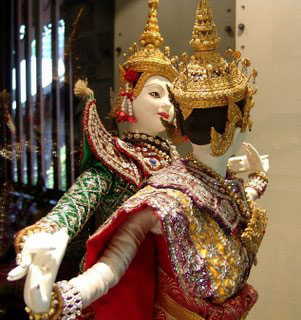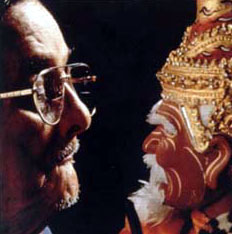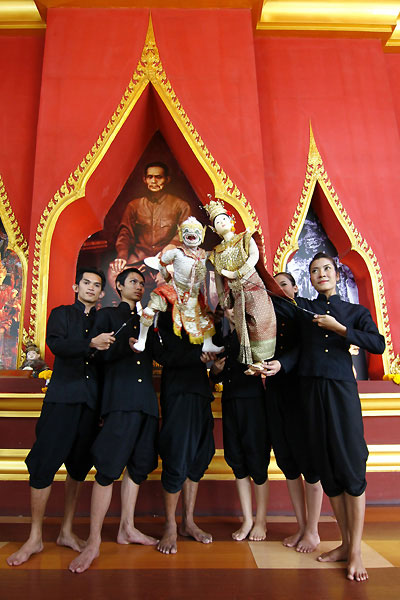|
Here you go. You enter in the Naatayasala to see Thai puppetry called "Hun Lakorn Lek" of Joe-Louis Theatre at Lumpini Night Bazaar, The latest performance received a special award: The best cultural performance in the festival of the Puppet Arts in June 2006 and celebrated the diamond jubilee anniversary for the King of Thailand.
A Thai style restaurant offers a spectacular picture of the ancient myth of Rahoo and lunar eclipse. You enjoy a delicious dinner with your family and friends after which you can take pictures with the Hun Lakorn Lek team and their traditional Thai small puppets with special lifelike characteristics combining many different kinds of traditional art forms before the showtime.
Thai puppetry has been a part of Thai culture and tradition for many centuries. The first puppet performance was called "Hun Luang" otherwise known as the Royal Puppets. It began during the Ayutthaya period, but only during royal functions or within the royal palace.
Later, during the reign of the king Rama IV, Hun Lek, or small puppets, performed Niew Jeen (Chinese Opera) and the Ramayana along with "Hun Krabok" (stick puppets) for the public and were performed widely all through the country.

Hun Lakorn Lek, from master Sakorn Yangkeawsot ("Joe Louis"), came back to the stage again in 1985. The uniqueness of these puppets is in their human-like movement and speech.
 Hun Lakorn Lek is continuing its tradition by passing down its knowledge to the next generation in the opening a children's puppet theater, preparing them for performance as well as to love and appreciate this old traditional art form. Hun Lakorn Lek is continuing its tradition by passing down its knowledge to the next generation in the opening a children's puppet theater, preparing them for performance as well as to love and appreciate this old traditional art form.
The JoeLouisTheater and Sakornnadtasin Puppet Troupe are a family of more than 10 people. They have constantly improved their performances throughout the years by not limiting temselves to just standard stages and backdrops**allowing aperformances in any-size area, incorporating today's social issues as well modern speech and jargon, but taking into great account not to diminish the original form. These improvements and changes have made audiences enjoy and feel a part of each performance, and helped to preserve and ensure that this art will not be lost.
Tonight is a special night for you:
The Myth of Rahoo and Lunar Eclipse.
It is a tale selected from Ramayana epic.
When you step into the theatre, you find that you are an important guest of Joe-Louis. During the 50 minutes of the play, you see the first scene narrated by the hermit puppet, and then a comedian puppet brings you the story. Three performers control one male puppet. Two performers control one female puppet and one performer controls a servant puppet. Thai musicof the Pi Paat Band is used to introduce the story. Male performers wear "Jong Kra Ben" instead of trousers.

Here is the synopsis of The Myth of Rahoo and the Lunar Eclipse:
Once upon a time, the sage-wizard Turawat went to visit heaven. While he was walking in the garden there, an angel gave him a garland. He was very happy. When he saw the senior god, Pra Inn, on the back of an elephant, he gave him the garland. Pra Inn thanked him and placed the garland on the head of the elephant. The fragrance of the garland was so strong, however, that the elephant went into musk. It took the garland off its head and threw it on the ground and crushed it under its feet. Turawat was offended: he thought the elephant did this on the command of Pra Inn. In anger, he casts a spell on all deities to reduce their powers.
The puppet performance of the myth starts with the invasion of heaven by the demons. The weakened deities fight, but they always lose. The scene changes and shows Pra Narai, a senior god, sleeping on the coiled Lord of the Great Serpent, Praya Naga. The god is awakened and told of the catastrophe. Pra Narai says he cannot undo the spell, but suggests another solution: the deities must drink Amarit, the elixir of life.
This elixir is difficult to obtain. The deities and the demons must stop fighting and cooperate to get it. The deities and the demons agree on a truce. The demons think that they, too, will be able to drink the elixir. The news of the truce and the quest for Amarit spreads. The arch-demon, Rahoo, hears about it. He sneaks over to the place where the elixir is being produced and waits for an opportunity to snatch it.
When the show ends and curtain closes, Hanuman (the monkey puppet) plays with audience members nearby. He performs a small play called."Hanuman Jab Nang (Monkey Chases A Lady). This makes people laugh especially young children. When it's over, many people take pictures with the puppets before the last farewell.
The beauty of puppet theatre is in the beauty of people, not only in Thailand, but everywhere.
For more information:
www.joelouis-theater.com
|
